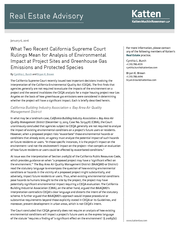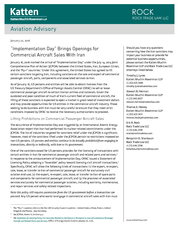What Two Recent California Supreme Court Rulings Mean for Analysis of Environmental Impact at Project Sites and Greenhouse Gas Emissions and Protected Species – January 6, 2016
Katten Muchin Rosenman
Description
emissions projections needed to meet AB 32’s 2020 goal (determined by the California Air Resources Board in its 2008 Climate
Change Scoping Plan to be a reduction of 29 percent from BAU). Because the EIR estimated actual annual project emissions that
were 31 percent below its BAU (and therefore exceeded the 29 percent statewide reduction goal), the EIR concluded the project’s
greenhouse gas emissions would not impede achievement of AB 32’s goals and the cumulative impacts of the project are less than
significant for CEQA purposes.
Petitioners Center for Biological Diversity (CBD) argued that this reduction from BAU criterion constituted an improper
hypothetical future baseline such that actual existing reduction from emissions at the site was not compared to the likely
emissions of the project. The Court disagreed, finding that the reduction from BAU was not used as a stand-in for baseline
conditions but was instead used as an “efficiency” metric for determining the significance of future emissions associated with the
project, which was allowed under CEQA. The Court, however, held that DWF’s methodology was too simplistic in applying the 29
percent AB 32 reduction goal, without adjustment, to a particular project in order to find the project effects less than significant.
The statewide goal “was developed … as a measure of the greenhouse gas reduction effort required by the state as a whole,”
emphasized the Court, and was not developed to apply to any particular project or activity.
Accordingly, in order to substantiate a less than significant finding using the reduction from BAU metric, a lead agency would have to show that it considered reductions from all types of sources throughout the state used to develop the statewide goal and make an appropriate adjustment applicable to the particular project at issue. Given DWF’s failure to consider any adjustments to the statewide target, its finding was not supported by substantial evidence, and the issue was remanded to the agency for reconsideration. The Court went beyond its holding to explain that it did not view its decision as creating an unreasonable burden on lead agencies to satisfy CEQA, noting that the “burden of CEQA’s mandate in this context can be substantial,” but asserting that “methods for complying” do exist. Perhaps sensing the likely complexity of demonstrating an appropriate adjustment to the BAU reduction goal, the Court suggested potential alternative approaches.
First, a lead agency may show that the project design features comply with regulations to reduce emissions and may demonstrate that those components of emissions are less than significant. A lead agency also could demonstrate compliance with locally adopted climate plans, or given the current lack of statewide standards, apply specific numerical thresholds developed by some local agencies. Finally, the Court acknowledged that for large development projects like Newhall Ranch, where “hundreds of thousands of tons of greenhouse gasses [would be added] to the atmosphere,” a significance finding may not be avoidable. Even so, noted the Court, the lead agency still could approve the project with a statement of overriding considerations. Impacts to fully protected species.
The Court also held that mitigation measures intended to protect species from the impacts of construction, including relocating the unarmored three-spine stickleback fish, constituted a prohibited “take” of the protected species. According to the Court, “DFW may conduct or authorize capture and relocation of the strickleback as a conservation measure to protect the fish and aid in its recovery, but the agency may not rely in a CEQA document on the prospect of capture and relocation as mitigating a project’s adverse impacts.” The decision was not unanimous. Two dissenting justices would have ruled in favor of the developer of the project (though on slightly different grounds).
Both the developer and petitioner have filed petitions with the Supreme Court asking it to reconsider its decision on several grounds, including, on the part of the developer, that the holding based on the record failing to “disclose ‘substantial evidence’ to support the EIR’s no significant impact finding” was not raised by CBD in its opening brief and therefore was not properly before the Court. The Court will decide whether to grant a rehearing on this or any other issue by February 26, 2016. www.kattenlaw.com AUSTIN | CENTURY  CITY | CHARLOTTE | CHICAGO | HOUSTON | IRVING | LONDON | LOS  ANGELES | NEW  YORK | ORANGE  COUNTY | SAN  FRANCISCO  BAY  AREA | SHANGHAI | WASHINGTON,  DC Attorney advertising. Published as a source of information only.
The material contained herein is not to be construed as legal advice or opinion. ©2016 Katten Muchin Rosenman LLP. All rights reserved. Katten refers to Katten Muchin Rosenman LLP and the affiliated partnership as explained at kattenlaw.com/disclaimer. 3 1/6/16 .
Accordingly, in order to substantiate a less than significant finding using the reduction from BAU metric, a lead agency would have to show that it considered reductions from all types of sources throughout the state used to develop the statewide goal and make an appropriate adjustment applicable to the particular project at issue. Given DWF’s failure to consider any adjustments to the statewide target, its finding was not supported by substantial evidence, and the issue was remanded to the agency for reconsideration. The Court went beyond its holding to explain that it did not view its decision as creating an unreasonable burden on lead agencies to satisfy CEQA, noting that the “burden of CEQA’s mandate in this context can be substantial,” but asserting that “methods for complying” do exist. Perhaps sensing the likely complexity of demonstrating an appropriate adjustment to the BAU reduction goal, the Court suggested potential alternative approaches.
First, a lead agency may show that the project design features comply with regulations to reduce emissions and may demonstrate that those components of emissions are less than significant. A lead agency also could demonstrate compliance with locally adopted climate plans, or given the current lack of statewide standards, apply specific numerical thresholds developed by some local agencies. Finally, the Court acknowledged that for large development projects like Newhall Ranch, where “hundreds of thousands of tons of greenhouse gasses [would be added] to the atmosphere,” a significance finding may not be avoidable. Even so, noted the Court, the lead agency still could approve the project with a statement of overriding considerations. Impacts to fully protected species.
The Court also held that mitigation measures intended to protect species from the impacts of construction, including relocating the unarmored three-spine stickleback fish, constituted a prohibited “take” of the protected species. According to the Court, “DFW may conduct or authorize capture and relocation of the strickleback as a conservation measure to protect the fish and aid in its recovery, but the agency may not rely in a CEQA document on the prospect of capture and relocation as mitigating a project’s adverse impacts.” The decision was not unanimous. Two dissenting justices would have ruled in favor of the developer of the project (though on slightly different grounds).
Both the developer and petitioner have filed petitions with the Supreme Court asking it to reconsider its decision on several grounds, including, on the part of the developer, that the holding based on the record failing to “disclose ‘substantial evidence’ to support the EIR’s no significant impact finding” was not raised by CBD in its opening brief and therefore was not properly before the Court. The Court will decide whether to grant a rehearing on this or any other issue by February 26, 2016. www.kattenlaw.com AUSTIN | CENTURY  CITY | CHARLOTTE | CHICAGO | HOUSTON | IRVING | LONDON | LOS  ANGELES | NEW  YORK | ORANGE  COUNTY | SAN  FRANCISCO  BAY  AREA | SHANGHAI | WASHINGTON,  DC Attorney advertising. Published as a source of information only.
The material contained herein is not to be construed as legal advice or opinion. ©2016 Katten Muchin Rosenman LLP. All rights reserved. Katten refers to Katten Muchin Rosenman LLP and the affiliated partnership as explained at kattenlaw.com/disclaimer. 3 1/6/16 .









